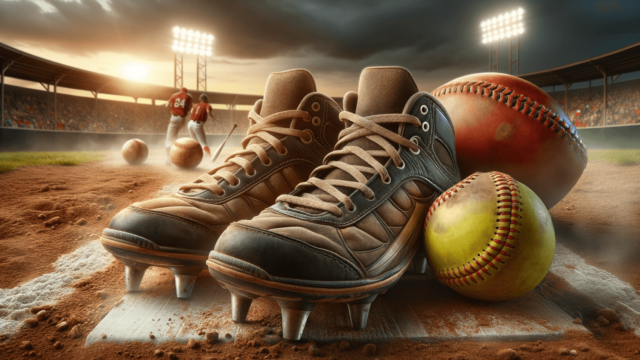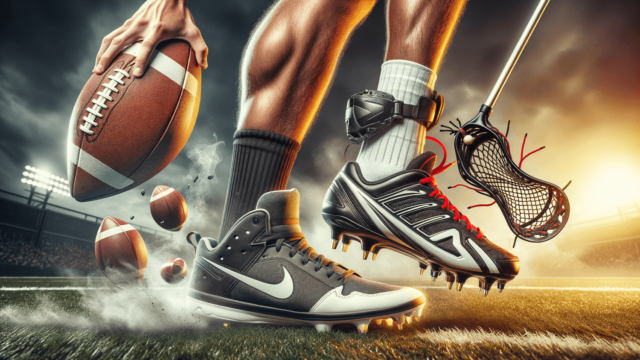
What is the Difference Between Football and Soccer Cleats
Written by: Football Universe
Last updated:

The main difference between football and soccer cleats lies in the cleat pattern and design: football cleats have thicker soles and a more prominent toe stud for better traction, while soccer cleats are lighter, ensure a better feel for the ball, and have fewer studs with uniform shapes and sizes. Both cleat types are tailored to the demands of their respective sports.
Difference Between Football and Soccer Cleats
It’s important to understand the differences between football and soccer cleats in order to select the right pair for your sport. Key factors that differentiate them include the cleat pattern and design, stud shape, and overall feel.
Cleat Pattern and Design
Football cleats feature thicker, more rigid soles designed to provide added support, even on uneven terrain. The design offers improved stability and traction, allowing for better acceleration and stopping ability. Soccer cleats, on the other hand, are designed with thinner, more flexible soles to offer enhanced agility and better ball control. This lighter profile allows soccer players to make quick turns and precise moves on the field.
Stud Shape and Placement
The cleat pattern and stud placement on football and soccer cleats are also distinct. Football cleats often have a prominent toe stud for enhanced traction and quick starts. This toe stud is absent in soccer cleats. Moreover, the studs on football cleats are a mix of sizes, shapes, and materials, depending on the player’s position and specific needs. Conversely, soccer cleats typically have fewer studs, which are uniformly round or bladed and made of solid plastic or rubber.
Overall Feel and Function
Last but not least, the overall feel and function of the shoes differ. Football cleats are heavier and more rigid to accommodate the demands of the sport, including tackling, blocking, and abrupt movements. Soccer cleats, on the other hand, prioritize a snug fit, lighter weight, and increased ball-contact surface area for precise ball manipulation and footwork.
Selecting the Right Cleats for Your Sport
Understanding the differences between football and soccer cleats can help you make the appropriate choice for your sport, ultimately optimizing performance, comfort, and safety. Aside from cleat design, cleat pattern, and overall feel, factors such as playing surfaces, personal preferences, and compatibility with the unique demands of your playing position should influence your decision.
Playing Surfaces
Creating adequate traction on different playing surfaces is crucial for both football and soccer players. Firm ground (FG) cleats are ideally suited for natural grass fields and work well in most weather conditions. For artificial turf or hard ground, consider artificial grass (AG) cleats with shorter studs that provide optimal grip without causing excessive strain on the joints.
Personal Preferences and Comfort
Comfort and fit are critical elements when choosing cleats. Players should consider factors such as foot shape and width, arch support, and cushioning to find a pair that fits snugly yet comfortably. Additionally, the design and construction materials vary across cleats, offering varying levels of breathability and durability. These factors should also be considered to ensure compatibility with individual preferences and needs.
Position-Specific Needs
In both football and soccer, different playing positions demand specific requirements from cleats. For example, linemen in football may prefer cleats with added ankle support, while soccer forwards may opt for lighter cleats that enable quick footwork. Assess the unique demands of your position to make an informed choice.
Maintaining Your Cleats
To maximize their performance and longevity, it’s important to take care of your cleats. Keep them clean by removing dirt and mud after each use, and inspect them regularly for worn studs or other signs of damage. Replace damaged cleats or studs as needed, and avoid using your cleats on inappropriate surfaces that may cause rapid wear or even injury.
FAQ Section
After learning about the differences between football and soccer cleats, you may have additional questions about the footwear. Explore this FAQ section to find concise answers to common queries related to selecting and maintaining the right cleats for your sport.
Can I use soccer cleats for football or vice versa?
Though not ideal, using soccer cleats for football or football cleats for soccer is possible in informal settings. However, using the appropriate cleats specifically designed for your sport is recommended for optimum performance and safety, particularly in competitive play.
How do I choose the correct size for my cleats?
To find the right size, use a sizing chart from the cleat’s manufacturer, and measure your feet accurately. Cleats should fit snugly, but not too tightly, to provide optimal foot support and prevent blisters. If possible, try on the cleats wearing the same socks you’ll use during play, and do a walk or jog test to ensure comfort and proper fit.
How often should I replace my cleats?
The lifespan of your cleats depends on factors such as frequency of use, playing surfaces, and wear and tear. Regular inspection of the cleats is crucial in identifying damaged studs, worn-out soles, or other signs necessitating replacement. Generally, cleats may require replacement every season or year, depending on usage.
Is it necessary to break in new cleats?
Yes, breaking in new cleats is recommended to avoid discomfort and blisters. Gradually increase the wear-time through practice sessions or light workouts before using the cleats in a full game. Avoid soaking or using heat to speed up the process, as this may damage the material or compromise the fit.
How can I clean my cleats effectively?
For effective cleaning, remove dirt and mud after each use by knocking the cleats together or using a brush. Avoid submerging them in water; instead, use a damp cloth or sponge to clean the upper part of the cleats. Dry them at room temperature, away from direct sunlight or heat sources, to prevent damage or deformation.
Featured Posts
- No pillar pages found.





